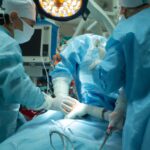Robotic surgery, a cutting-edge medical innovation, combines the precision of robotics with the skill of surgeons. Using state-of-the-art technology, these robots perform complex procedures with remarkable accuracy and dexterity. The surgeon controls the robot from a console, manipulating tiny instruments inside the patient’s body. This minimally invasive approach has numerous benefits, including reduced pain, smaller incisions, and faster recovery times. Patients often experience less scarring and bleeding, leading to improved outcomes. The robot’s robotic arms can rotate 360 degrees, providing unprecedented access to hard-to-reach areas. Despite its advantages, robotic surgery is not without its limitations, such as its high cost and the need for highly trained medical professionals. Nonetheless, the future holds great promise for this remarkable advancement in surgical techniques.
Table of Contents
- Advantages of robotic surgery
- Applications of robotic surgery
- Comparisons with traditional surgery techniques
- Disadvantages of robotic surgery
- Future developments in robotic surgery
(A Look at Our Da Vinci Robotic Surgery System)
Robotic surgery has revolutionized the field of medicine, providing surgeons with enhanced precision and improved patient outcomes. With its advanced technology, this cutting-edge approach allows for less invasive procedures, reduced pain, and faster recovery times.
The da Vinci Surgical System is perhaps the most well-known robotic surgical platform. It consists of a console where the surgeon sits, immersing themselves in a 3D surgical site view, and robotic arms that execute their movements with extreme accuracy. These arms are equipped with miniaturized surgical tools that can maneuver within the patient’s body, mimicking the surgeon’s hand movements.
One of the key advantages of robotic surgery is its ability to perform complex procedures with incredible precision. The articulating instruments can rotate and bend beyond the human hand’s capabilities, allowing surgeons to access hard-to-reach areas. This means that even in delicate surgeries, such as cardiac or spinal procedures, robotic-assisted techniques reduce the risk of complications.
Moreover, robotic surgery minimizes tissue damage, resulting in smaller incisions and less scarring. Patients experience reduced pain and bleeding during and after the procedure. Additionally, the shorter recovery period allows individuals to return to their daily activities more swiftly, improving their overall quality of life.
While some may worry about the potential loss of personal contact between surgeon and patient, the reality is that the surgical team remains present throughout the procedure. The surgeon is in control of every move made by the robotic arms, ensuring a human touch is still an integral part of the process.
Robotic surgery represents a significant step forward in the field of medicine. Through its precise movements, reduced invasiveness, and faster recovery times, it is transforming the way surgeries are performed and enhancing patient outcomes. As technology continues to advance, we can expect further developments in this exciting field.
Advantages of robotic surgery
Robotic surgery offers several advantages over traditional surgical procedures. Firstly, it allows for enhanced precision and accuracy. The robotic arms used in these surgeries can make movements with a greater range of motion, providing surgeons with better control. This increased precision results in improved outcomes and reduced risks for patients.
Another advantage is the minimally invasive nature of robotic surgery. Instead of making large incisions, only small, precise incisions are made. As a result, patients experience less pain, minimal scarring, and a faster recovery time. This less invasive approach also reduces the risk of post-surgery complications and infections.
Robotic surgery also enables surgeons to access hard-to-reach areas inside the body more easily. The robotic arms can be maneuvered into tight spaces, allowing for procedures that might otherwise be challenging or impossible. This expands the range of surgeries that can be performed using minimally invasive techniques.
Furthermore, the implementation of robotic surgery can lead to reduced blood loss during procedures. The robotic arms can cauterize blood vessels as they operate, minimizing bleeding and the need for blood transfusions. This is particularly important for patients with certain medical conditions or those who are more prone to bleeding.
In addition, the use of robotic technology in surgery can improve the overall patient experience. The shorter recovery period means patients can resume their normal daily activities faster, leading to increased patient satisfaction. The reduced pain and scarring also contribute to a smoother recovery process and improved quality of life post-surgery.
Lastly, robotic surgery allows for telesurgery, also known as remote surgery. This technology enables surgeons to operate on patients who are located in different geographical locations. This can be particularly beneficial in areas where specialized surgical expertise may be limited, allowing patients to receive high-quality care from skilled surgeons regardless of their location.
In conclusion, robotic surgery offers numerous advantages over traditional surgical methods. Enhanced precision, minimally invasive techniques, improved access to hard-to-reach areas, reduced blood loss, improved patient experience, and the potential for telesurgery are all benefits that make robotic surgery an increasingly popular choice in the medical field. As technology continues to advance, it is likely that these advantages will only become more pronounced, further revolutionizing the field of surgery.
Applications of robotic surgery
Robotic surgery has revolutionized the field of medicine, offering numerous applications that have the potential to transform patient outcomes. One of the key areas where robotic surgery has shown great promise is in minimally invasive procedures. By utilizing robotic arms controlled by skilled surgeons, operations can be performed through small incisions with greater precision and accuracy.
One significant application of robotic surgery is in the field of urology. Procedures such as prostate removal, bladder reconstruction, and kidney surgeries can be performed with greater precision and minimal invasiveness. This leads to reduced blood loss, shorter hospital stays, and faster recovery times for patients.
In gynecology, robotic surgery has opened up new possibilities. It allows for complex surgeries such as hysterectomies and myomectomies to be performed with greater precision and reduced trauma to surrounding tissues. With robotic assistance, surgeons can navigate tight spaces and perform intricate maneuvers with ease, leading to improved patient outcomes.
Cardiothoracic surgery has also benefited greatly from robotic technology. Procedures such as mitral valve repair, coronary artery bypass grafting, and lung surgeries can all be performed using robotic systems. The smaller incisions and enhanced visualization provided by the robotic arms allow for greater precision, reducing the risk of complications and improving patient recovery.
In the field of general surgery, robotic technology has brought about a paradigm shift. Complex procedures like colorectal surgeries, bariatric surgeries, and hernia repairs can be approached with greater precision and reduced invasiveness. This translates to faster recovery times, reduced pain, and improved overall patient satisfaction.
Robotic surgery is not limited to a specific specialty; it has found applications in various other fields, including orthopedics, neurosurgery, and ENT surgery. In orthopedics, robotic systems can assist in joint replacement surgeries, ensuring precise implant placement and improved patient outcomes. In neurosurgery, robotics can aid in the removal of brain and spinal tumors, enhancing surgical precision and reducing the risk of damage to critical structures. In ENT surgery, robotic technology allows for intricate procedures like transoral robotic surgery for throat and tongue cancers.
Overall, the applications of robotic surgery are vast and continue to expand. This cutting-edge technology offers improved precision, reduced invasiveness, and enhanced patient outcomes across multiple specialties. As robotic systems evolve and become more widely available, the future of surgery looks promising, with potential advancements that will benefit patients around the world.
Comparisons with traditional surgery techniques
Comparisons with traditional surgery techniques reveal several advantages of robotic surgery. Firstly, robotic surgery offers greater precision and accuracy compared to traditional techniques. The robotic system provides surgeons with enhanced visualization, allowing for a more precise execution of surgical tasks. This precision minimizes the risk of errors and complications during the procedure.
Furthermore, robotic surgery offers a minimally invasive approach. In traditional surgery, large incisions are made, leading to significant tissue damage and longer recovery times. However, robotic surgery utilizes small incisions, resulting in less trauma to the patient’s body. This reduced invasiveness leads to faster healing, shorter hospital stays, and less post-operative pain.
In addition, robotic surgery offers improved dexterity for surgeons. The robotic system’s arms have a wider range of motion compared to human hands, allowing surgeons to perform complex maneuvers with ease. This enhanced dexterity enables surgeons to access hard-to-reach areas in the body and perform intricate surgical tasks effectively.
Another advantage of robotic surgery is the potential for reduced blood loss. The precision of the robotic system enables surgeons to control bleeding more effectively during the procedure. This reduced blood loss ultimately leads to a decreased need for blood transfusions, reducing the risk of complications and improving patient outcomes.
Moreover, robotic surgery offers patients shorter hospital stays. Due to its minimally invasive nature, patients who undergo robotic surgery typically experience a faster recovery and can return to their daily activities sooner compared to patients who undergo traditional surgery. This shorter hospital stay not only improves patient comfort but also reduces healthcare costs.
Although robotic surgery has several advantages, it is important to note that it is not suitable for all surgical procedures. Some complex surgeries may still require traditional techniques due to the limitations of the robotic system. Additionally, the cost of robotic surgery can be higher compared to traditional surgery, limiting its accessibility in certain healthcare settings.
Overall, robotic surgery presents several advantages when compared to traditional surgery techniques. Its precision, minimally invasive approach, improved dexterity, reduced blood loss, and shorter hospital stays make it an appealing option for many surgical procedures. However, further research and advancements in technology are needed to fully maximize the potential of robotic surgery in the field of medicine.
(Da Vinci Robotic Surgery Program: Robot-Assisted Laparoscopic Surgery l Cleveland Clinic Abu Dhabi)
Disadvantages of robotic surgery
Robotic surgery, despite its many advantages, also comes with certain disadvantages that need to be considered. One major disadvantage is the high cost associated with robotic surgery. The technology itself is expensive, and hospitals need to invest in specialized equipment and training for the surgeons. This cost is ultimately passed on to the patients, making robotic surgery a more expensive option compared to traditional surgery.
Another disadvantage is the limited availability of robotic surgery. Not all hospitals have access to robotic systems, which means that patients who could potentially benefit from this technology may not have the option. This lack of accessibility can be a major drawback, especially for those in rural or remote areas where robotic systems are not available.
Robotic surgery also requires a longer setup time compared to traditional surgery. The robotic system needs to be properly calibrated and positioned before the procedure can begin. This setup time can add precious minutes or even hours to the overall surgery time, which can be a concern in emergency situations where time is of the essence.
Additionally, robotic surgery relies heavily on technology and can be susceptible to technical difficulties. If the robotic system malfunctions or experiences technical issues during the surgery, it can disrupt the procedure and potentially lead to complications. Surgeons and support staff need to be well-trained in troubleshooting and problem-solving when it comes to robotic systems to ensure patient safety.
Furthermore, some critics argue that robotic surgery may lead to a decrease in the surgeon’s skills. With the robot performing many of the precise movements, there is a concern that surgeons may become less experienced in performing manual surgeries. This loss of skill could have consequences if a surgeon needs to switch to traditional surgery due to technical difficulties or other reasons.
Lastly, a significant disadvantage of robotic surgery is that it is not suitable for all types of procedures. Some complex surgeries or those involving delicate structures may require the dexterity and tactile feedback that can only be provided by a human surgeon. In these cases, traditional surgery may still be the preferred method.
In conclusion, while robotic surgery offers many benefits, it is important to be aware of its disadvantages. The high cost, limited availability, longer setup time, potential for technical difficulties, concerns about the surgeon’s skills, and limitations in certain procedures are all factors that need to be considered when evaluating the use of robotic surgery. It is crucial to have a holistic understanding of the pros and cons before making any decisions.
Future developments in robotic surgery
Future developments in robotic surgery will revolutionize the field, bringing forth incredible advancements and possibilities. One such development is the integration of artificial intelligence (AI) into robotic surgical systems. By combining AI with robotic technology, surgeons will benefit from enhanced precision, efficiency, and decision-making capabilities.
AI algorithms can analyze vast amounts of patient data, including medical records, imaging scans, and genetic information, to provide real-time insights during surgeries. This will enable surgeons to make informed decisions and adapt their approach according to each patient’s specific needs. Additionally, AI-powered robots can learn from every procedure, continuously improving their performance and accuracy.
Another exciting development is the miniaturization of robotic surgical instruments. As technology progresses, robots are becoming smaller and more flexible, allowing for minimally invasive procedures. These tiny robots can navigate through narrow pathways and delicate anatomical structures, reducing the risk of complications and improving patient outcomes.
Moreover, advancements in haptic feedback technology will enhance the surgeon’s sense of touch, a crucial aspect of surgical procedures. This technology can recreate tactile sensations, enabling surgeons to feel the tissues they are operating on remotely. Improved haptic feedback will further enhance the precision and dexterity of robotic surgical systems.
Additionally, telemedicine is set to play a significant role in the future of robotic surgery. With the help of high-speed internet and real-time video streaming, surgeons will be able to perform surgeries remotely. This has the potential to address disparities in access to surgical care, allowing patients in underserved areas to benefit from the expertise of skilled surgeons located elsewhere.
Furthermore, the integration of augmented reality (AR) into robotic surgical systems will provide surgeons with an immersive, 3D visualization of the surgical field. Surgeons will be able to overlay important information, such as vital signs and anatomical landmarks, directly onto their field of view, improving accuracy and reducing the risk of errors.
In conclusion, the future of robotic surgery holds great promise. The integration of AI, miniaturization of robots, haptic feedback technology, telemedicine, and AR will bring about revolutionary advancements in the field. These developments will improve surgical outcomes, increase access to care, and pave the way for new possibilities in healthcare. It is an exciting time for robotic surgery, as we witness the transformation of an already remarkable field into something even more extraordinary.













